



19. The Green
Robert Webber was born in Litton, the son of William and Mary and husband of Mary. In 1939 his mother was living at 1, The
Green. He was an able seaman on the aircraft carrier HMS Glorious and died on the 9
th
of June when it was sunk by the
German battle cruiser Scharnhorst near the Lofoten Islands, Norway. His body was never recovered for burial. He is
commemorated on the Plymouth war Memorial.
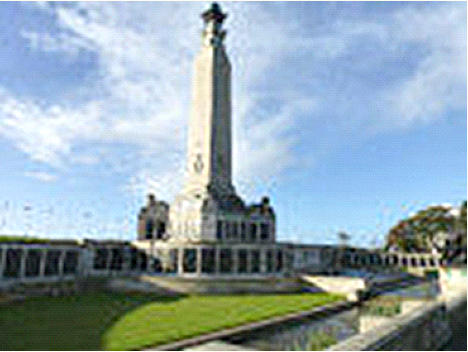
Also
at
the
Green
was
Charlie
Fry,
the
local
builder
with
his
wife
Emma
and
children
Ruth,
aged
9
and
Edward,
aged
5.
Frederick Cleal, a builder’s mason was a lodger.
Belinda
Brocklehurst
recalls
next
door
to
my
grandparent’s
house
lived
the
Fry
Family.
Charlie
Fry
was
the
local
carpenter
and
builder,
and
he
had
a
huge
builder’s
shed.
Their
son
Edward
was
a
little
older
than
me
and
my
‘best
friend’
in
the
village-
I’m
not
sure
he
would
agree
with
that,
but
he
was
allowed
to
come
and
play
in
the
garden
sometimes.
His
older
sister
Ruth
was
very
dear
to
us
and
sometimes
helped
our
nanny,
and
her
elder
sister
looked
after
Ginie
for
a
short
time
when
our
nanny
Winifred
was called up for war service.
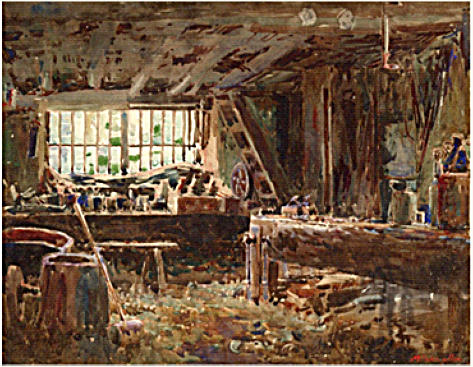
Plymouth War Memorial
Wheelwright’s Shed at the Green
20. The Home Guard
The
Home
Guard
was
set
up
in
May
1940
as
Britain’s
‘last
line
of
defence’
against
German
invasion.
Members
of
this
‘Dad’s
Army’
were
usually
men
above
or
below
the
age
of
conscription
and
those
unfit
or
ineligible
for
front
line
military
service.
On
14
May
1940,
Secretary
of
State
for
War
Anthony
Eden
made
a
broadcast
calling
for
men
between
the
ages
of
17
and
65
to
enrol
in
a
new
force,
the
Local
Defence
Volunteers
(LDV).
By
July,
nearly
1.5
million
men
had
enrolled,
and
the
name
of
this
people’s
army was changed to the more inspiring Home Guard.
The
Home
Guard
was
at
first
a
rag-tag
militia
with
scarce
and
often
make-do
uniforms
and
weaponry.
Yet
it
evolved
into
a
well-
equipped
and
well-trained
army
of
1.7
million
men.
Men
of
the
Home
Guard
were
not
only
readied
for
invasion
but
also
performed
other
roles
including
bomb
disposal
and
manning
anti-aircraft
and
coastal
artillery.
Over
the
course
of
the
war
1,206
men of the Home Guard were killed on duty or died of wounds.
With
the
Allied
armies
advancing
towards
Germany
and
the
threat
of
invasion
or
raids
over,
the
Home
Guard
was
stood
down
on 3 December 1944.
Charles
Baumber
from
the
Paddocks
remembered
that
before
Anthony
Eden
had
finished
his
broadcast
(May
1940)
I
had
enrolled
in
the
LDV
(Local
Defence
Volunteers)
at
Litton
Cheney
Police
Station,
which
PC
Trevett
can
verify.
I
served
throughout
the
war
under
the
command
of
Colonel
Duke
of
Martinstown,
with
Lt.
Col.
Newman
as
platoon
commander,
and
I
did
not
miss
a
parade
or
guard
for
three
years
and
then
it
was
owing
to
my
daughter’s
illness.
After
her
death
I
continued
parades
and
beach
patrols
as
usual.
Also,
when
we
were
expecting
the
invasion
of
our
part
of
the
coast
and
when
“Jerry”
used
to
come
overhead
with
hundreds
of
planes
bombing
and
machine-gunning.
I
carried
a
rifle
or
Browning
automatic
to
and
from
work
for
two
years
with full magazines, ready for a low flying “Jerry”. When the Home Guard were stood down, I held the rank of corporal.
William
Watson
of
the
Durham
Light
Infantry
recalled
one
of
the
things
I
had
to
do
was
to
liaise
with
the
Home
Guard
and
going
back
a
bit,
about
17
th
July
I
went
to
Dorchester
conference
in
the
Assize
Court
with
my
Brigadier,
Old
Jackie
Churchill,
Jackie
sat
in
the
Judge’s
seat
in
the
Assize
Court
and
I
really
think
he
thought
he
was
Judge
Jefferies
sitting
there
dispensing
justice.
It
was
an
extremely
good
Home
Guard
Conference.
They
were
LDV,
Local
Defence
Volunteers
in
those
days
and
they
all
wanted
to
cooperate
with
us
except
for
the
MP,
old
Colfax,
he
really
didn’t
see
much
object
in
joining
in
the
Home
Guard
cooperation.
Eventually
we
got
the
Home
Guard
on
a
very
high
footing.
My
view
was
that
no
attempt
should
be
made
to
make
them
Grenadier
Guardsmen.
They
should
be
what
they
were,
Home
Guard
and
they
should
use
their
own
ingenuity
and
individuality
in
the
areas
which
they
knew
and
to
go
further
than
this
would
upset
the
whole
apple
cart
and
upset
the
whole
object
of
the
force.
They
shouldn’t
have
military
parades
and
all
that
sort
of
thing,
they
should
be
capable
of
dealing
with
tanks,
surprises
at
the end of the village street, and search out any parachutists, which of course they did. Much more like a guerilla force.
We
were
always
helping
the
Home
Guard.
At
the
end
of
August
Colonel
Peter
Jefferies
was
commanding
the
Battalion
and
he
staged
a
tank
trap
so
that
the
Home
Guard
could
deal
with
tanks
entering
the
village
from
various
directions
and
we
put
that
demonstration
on,
how
to
deal
with
tanks
one
evening,
about
22
nd
August.
We
had
the
whole
of
the
Home
Guard
watching,
and
it
was
extremely
successful,
all
went
so
well.
The
Home
Guard
were
greatly
impressed
and
afterwards
they
went
through
it
all
merely
as
a
drill,
not
as
an
exercise.
They
chose
the
windows
from
the
houses
to
throw
the
Molotov
cocktails
from
and
they
went
behind
the
hedges,
behind
the
walls
to
toss
the
bombs
and
grenades
into
the
approaching
carriers.
Our
carriers
had
acted
as tanks.
Belinda
Brocklehurst
recalled
my
grandfather,
a
retired
Indian
Army
Colonel,
ran
the
Home
Guard
for
the
area.
He
ran
exercises
which
involved
his
troop
of
quite
elderly
or
unfit
men
crawling
around
the
countryside
and
laying
booby
traps
and
ambushes.
Sometimes
I
was
allowed
to
join
them.
Eventually
they
were
given
guns
and
live
ammunition,
and
he
was
able
to
have
shooting
practice
in
the
garden.
I
used
to
love
collecting
the
small
golden
spent
bullets
afterwards.
He
would
take
me
out
to
‘help’
him
shoot
rabbits
and
pigeon
for
the
pot
and
to
catch
little
brown
trout
in
the
tiny
Bride
River.
They
all
helped
to
eke
out
our meagre food rations and were also given to the older people in the village.
I
remember
an
evening
when
the
telephone
went
and
everyone
became
very
serious,
there
was
a
flurry
of
activity,
and
a
label
was
tied
round
my
neck.
Apparently,
a
secret
code
word
had
been
passed
to
the
colonel
of
the
local
regiment
who
was
dining
with
my
grandparents,
I
think
Operation
Chamberlain,
which
meant
the
Germans
were
invading.
My
grandfather
and
mother
(who
had
also
joined
the
Home
Guard)
went
off
to
fight
on
the
beaches,
leaving
the
rest
of
us
to
fend
for
ourselves.
Fortunately,
this was a false alarm, and though a group of ships had been spotted, they did not invade. It was later thought to be a trial run.
My
grandfather
was
very
busy
running
the
Home
Guard
and
had
a
lot
of
meetings
in
the
house
and
firing
practice
on
the
tennis
lawn
when
they
used
live
rifles
and
shot
at
targets
on
the
bank.
Occasionally
there
was
an
exercise
between
the
Home
Guard
and
the
local
soldiers
stationed
in
the
village.
One
side
was
the
Germans
and
the
other
the
British.
I
remember
a
terrible
occasion
when
the
Home
Guard
were
the
British
and
the
soldiers
Germans
were
very
much
the
winners.
It
was
very
realistic,
and
I
found
some
of
them
crawling
around
in
the
garden
and
was
told
to
run
for
it.
At
the
end
of
the
day,
various
members
of
the
Home
Guard
were
led
off
to
be
shot
by
the
big
tree
at
Cross
Ways.
One
of
these
was
Charlie
Fry,
Edward’s
father,
and
Edward
was
sobbing
his
heart
out
as
he
watched
his
father
led
away.
Occasionally
I
went
with
my
grandfather
to
inspect
points
on
the
coast
and
some
places
where
arms
were
kept.
One
day
we
went
to
see
where
some
bombs
had
landed,
two
huge
craters
near
the
coast
road
above
Bexington.
We
went
down
to
Bexington
where
the
fields
on
both
sides
of
the
village
and
along
the
coast
were
all
heavily
mined.
Suddenly
a
small
dog
came
running
towards
us
across
the
mine
field
and
I
was
thrown
to
the
ground
with my large grandfather on top of me, in case the mines went off. Fortunately, it was a very small dog, and nothing happened.
Lt.
Col.
Drew
of
the
Home
Guard
drew
a
map
entitled
‘Litton
Cheney
Defence
Scheme’
showing
roadblocks,
gun
positions,
anti-tank mines etc., mostly around White Cross and the Mount.
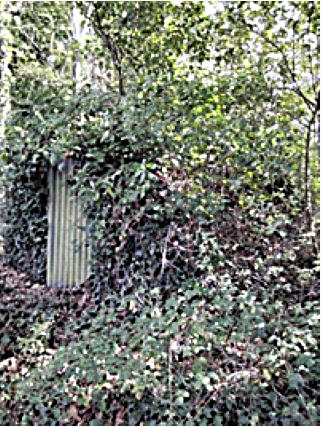
Home Guard Hut in Hines Mead Lane.
21. The Cottage
Alexander,
a
retired
Indian
Army
Officer
and
Clare
Harper
were
here
in
1939
with
their
son
Ian,
a
Lieutenant
in
the
Cheshire
Regiment
and
Sylvia
Couzens,
aged
87.
Anne
Griffith
was
a
children’s
nurse
and
Ella
Bettsack
a
cook
and
housekeeper.
The
Harpers
had
taken
in
Ella,
a
Jewish
refugee
from
Hirschberg
in
Germany.
Born
in
1896
she
had
been
a
shopkeeper
in
Germany.
The
Harper’s
daughter
and
grandchildren,
Belinda
and
Ginie
came
to
live
with
them
in
1940.
Belinda
Brocklehurst
recalled
her
arrival
at
the
Cottage
in
1940
a
s
we
ran
into
the
house
we
found
a
haven
of
peace,
despite
the
‘dog
fight’
going
on
overhead.
My
grandmother
was
in
the
drawing
room
pouring
out
tea.
My
grandfather
sat
smoking
his
pipe
in
a
large
armchair,
his
two
dogs,
lying
at
his
feet.
Great
Aunt
Sylvia
sat
in
her
rocking
chair
doing
her
knitting.
The
‘Dog
Fight’
was
a
fascinating
and
horrifying
sight
with
our
brave
fighter
planes
swirling
around
above
us
in
the
blue
sky
as
they
tried
to
shoot
down
German
bombers on their way to bomb Bristol and Exeter- the period was the height of the Battle of Britain.
When
the
war
started
Colonel
Harper
took
over
the
running
of
the
Home
Guard.
He
had
a
grey
Singer
car
and
later
got
petrol
coupons
because
of
this
role.
He
belonged
to
‘The
Club’
in
Bridport
and
every
Saturday
went
there
to
meet
his
mates
and
have
a pink gin with Captain Perry.
George
Innes
Watson
of
the
Durham
Light
Infantry
was
billeted
here
from
June
to
September
1940.
He
recalled
I
must
say
about
the
kindness
of
the
inhabitants.
I
moved
my
billet
to
the
house
of
a
man
called
Colonel
Harper
and
his
good
wife
slaved
away
at
the
little,
tiny
YMCA
we
had
in
the
village,
and
he
couldn’t
have
been
kinder,
I
never
wanted
to
move,
he
was
a
charming
old
man.
He
had
commanded
the
3
rd
Punjabs
and
he
had
a
son,
who
subsequently
after
the
war
was
a
brilliant
polo
player,
he’d
been
in
the
Indian
Cavalry,
and
he
was
an
international
polo
player.
He
had
another
son,
poor
chap
who
was
drowned in HMS Thistle and he had a married daughter.
One
day
I
went
back
to
my
billet
to
get
something
out
of
my
room
and
I
left
my
cap
on
the
chest
in
the
hall
and
I
came
down
and
I
couldn’t
find
my
cap,
there
was
a
cap
lying
there
with
a
red
hat
band
and
I
could
hear
the
old
man’s
voice
in
the
study
talking
away
so
I
thought,
oh
well,
there
must
be
someone
from
District
or
Higher
Command
having
a
word
with
the
old
man,
not
a
bit
of
it.
I
picked
up
the
cap
with
the
red
cap
band
around
and
it
was
mine.
The
old
man
had
put
a
red
cap
band
round,
I
suppose hopefully thinking that someday I would actually be wearing one. It was a long time before I did. He was so kind to me.
There
were
lots
of
little
streams,
coming
down
off
the
downs,
chalk
streams
and
there
was
one
in
particular
that
ran
through
a
meadow
just
below
the
village
and
he
took
me
out
fishing
there
one
day.
I
didn’t
catch
any,
but
he
caught
a
beautiful
trout
out
of
this tiny little runner that found its way across these water meadows.
He
gave
me
a
dinner
party
one
night
and
attending
it
was
a
chap
called
Colonel
Shute
who
I
remember
was
86.
He
said
he
was
in
the
Bloody
Munsters;
he
was
a
real
Irishman
and
when
he
got
really
worked
up
you
could
hardly
understand
a
word
he
said.
His
father
had
served
in
the
22
nd
Foot,
that’s
a
Cheshire
Regiment
in
Hyderabad,
one
of
their
great
battle
honours
of
that
particular
regiment.
He
had
a
wonderful
sense
of
humour
that
old
Colonel
Shute.
He
had
very
bad
rheumatism
in
his
knees,
and
he
was
quite
certain
that
the
surgeons
would
cut
his
legs
off.
Anyhow,
this
was
one
of
the
most
interesting
dinners
I
had
during
the
war,
old
Colonel
Shute
could
talk
about
things
that
one
never
realised
that
anyone
living
had
passed
through
that
particular
period of history.
Colonel
Harper
gave
me
a
splendid
dinner
when
I
left
for
the
last
time,
and
I
gave
him
before
I
left
a
dozen
bottles
of
1924
port,
and I said to the old man you’d better keep it for a bit don’t drink it all, not one after the other. It was no good, he soon finished it.
On
another
occasion,
an
orderly,
the
front
door
was
left
open
all
night,
would
come
in
and
wake
me
and
on
this
particular
occasion
there
was
an
alarm,
a
false
alarm
at
that,
and
the
orderly
ran
into
the
old
man’s
room
and
was
met
with
the
old
man
sitting up in bed with the revolver pointing at the orderly as he broke in through the door.
After
the
war
I
went
back
with
my
wife,
and
I
called
at
the
old
man’s
house
and
there
he
was
in
the
garden
looking
very
old
and
looking
very
aged.
I
said
to
him
you
won’t
remember
me
sir,
and
he
hesitated
and
all
he
said
was
“Watson
and
Jeffreys”,
he
remembered. I was so pleased and so was he. We talked about the old times of 1940.
Kenneth
Harper
was
the
son
of
Lieutenant
Alexander
Forrest
Harper
of
Litton.
He
died
on
14
th
April
1940
when
HMS
Thistle
was
torpedoed
and
sunk
with
all
hands
by
a
German
U-Boat
off
Skudenes,
Norway.
The
wreck
of
the
submarine
was
discovered by a Norwegian survey team in the spring of 2023 at a depth of 160 metres.
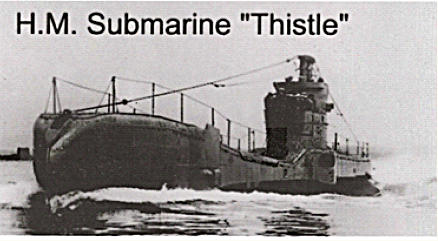
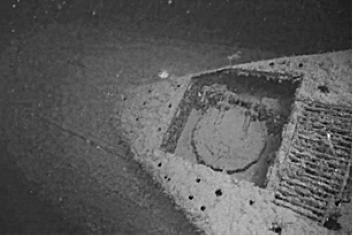
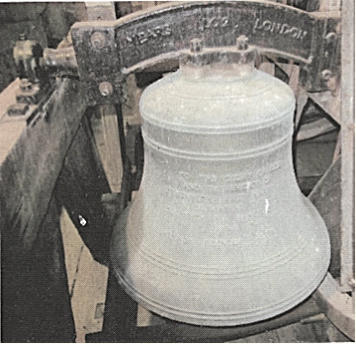
HM Submarine ‘Thistle’.
Wreck discovered in 2023..
Bell in memory of Kenneth Harper..
22. Court House
Charles and Gertude Newman moved to the Court House in 1939. Lieutenant Charles Newman was platoon Commander of a
Home Guard during the war.
Their
daughter,
Barbara
married
John
Clement
Van
der
Kiste
in
1939
and
during
the
war
he
was
a
Captain
in
the
2
nd
Battalion,
North Staffordshire Regiment. He died, aged 33 on the 27
th
of May 1940, the date when the Dunkirk evacuation began.
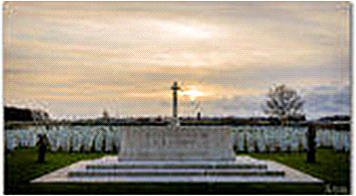
Oosttaverne Wood Cemetery, Heuvelland, Belgium
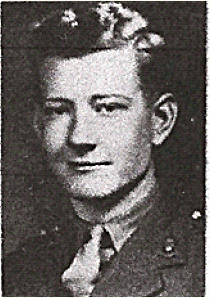
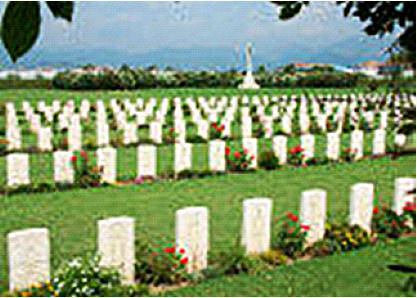
Salerno War Cemetery
Peter Newman
Belinda
Brocklehurst
recalls
across
the
road
from
my
grandparents
was
Court
Lodge,
a
large
attractive
house,
where
it
is
said
the
dreaded
Judge
Jeffries
had
court
sessions
in
the
1700s.
Mr
and
Mrs
Newman
lived
here
and
were
good
friends
and
very
long
suffering
about
me
going
over
and
playing
in
their
garden,
watching
Mr
Newman
and
his
bees,
and
the
swan
who
used
to
come
and
pull
a
string
by
the
back
door
to
ring
a
bell
and
get
some
food.
They
were
a
lovely
couple.
He
made
me
a
beautiful
replica
of
my
grandparent’s
house,
which
I
still
have
75
years
later!
Very
sadly
their
super
son
Peter
was
killed
in
the
war-
like
most
families
in
the
village,
everyone
seems
to
lose
someone
close
to
them.
I
still
remember
him
well,
he
seemed
so
tall
with
wavy
reddish
hair
and
a
lovely
smile,
and
he
was
so
patient
with
me,
a
constantly
chatting
skinny
four
to
five-year-old.
I
think
he
was killed when I was about six.
23. Charity Farm
24. Court House Barn
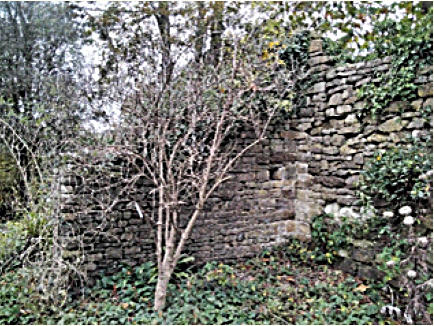
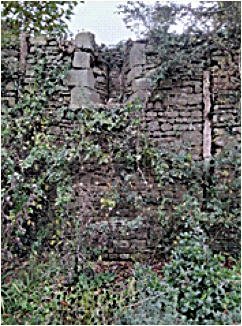
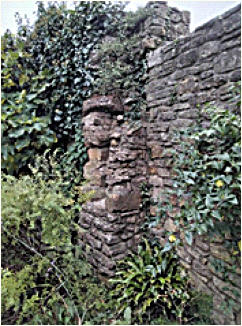
Barn walls from the south
The
seventeenth
century
Court
House
barn
was
a
stone
building
of
six
bays,
a
porch
on
the
south
side
with
a
collar-beamed
thatched
roof.
The
costly
maintenance
of
the
thatched
roof
caused
its
gradual
decay,
and
it
became
derelict
after
use
by
American
troops
in
the
Second
World
War.
Some
of
the
stone
was
used
in
the
building
of
Tithe
Barn
House
in
Chalkpit
Lane.
Today only part of the walls remain.
25. Faith House Barns
The
barns
were
used
by
the
army
in
the
Second
world
war.
War
time
graffiti
was
found
on
the
plaster
of
a
barn
and
a
vehicle
inspection pit was present. It is likely that vehicle maintenance took place here.
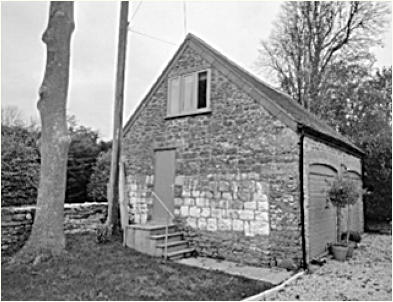
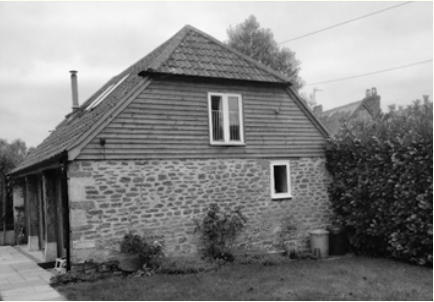
Victor
and
Anna
Trenchard
were
farming
here
in
1939
with
their
son
William
(Bill)
and
daughters
Anne
and
Mildred
assisting
on
the
farm.
Alfred
Wincey,
a
farm
labourer
was
lodging
here.
Thomas
Honeybun,
a
retired
shepherd
and
Alfred
Hussey,
a
cowman
were living in the neighbouring Charity Farm Cottages.
The
dairy
farm
had
98
acres
of
pasture,
including
water
meadows,
a
farmhouse,
two
cottages,
dairy
premises
and
farm
buildings.

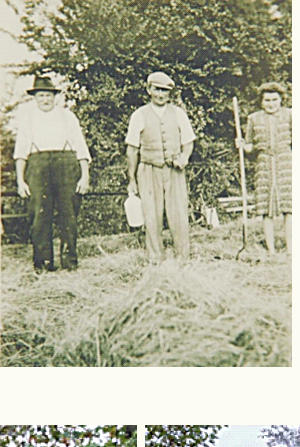
Victor Trenchard milking at Charity Farm
Victor, Bill and Mildred Trenchard







ABOUT LITTON CHENEY

LITTON CHENEY IN WARTIME





























